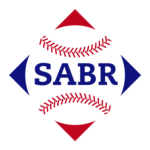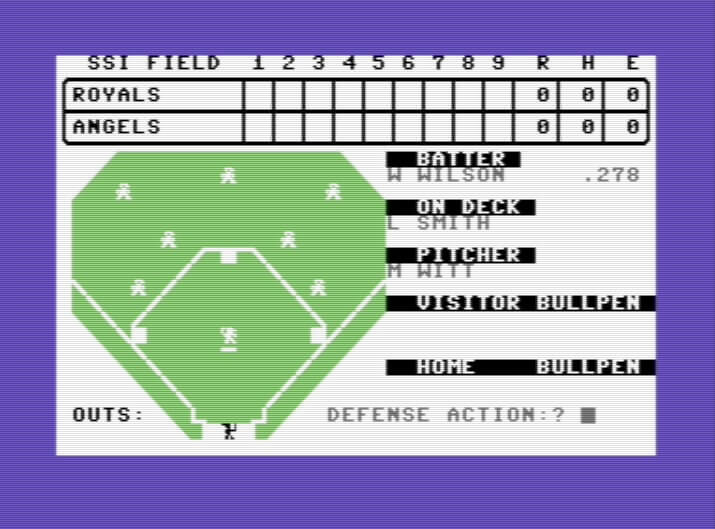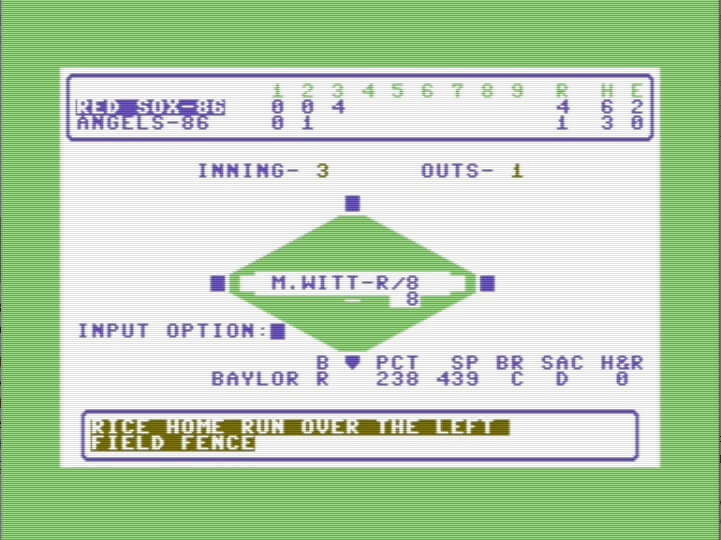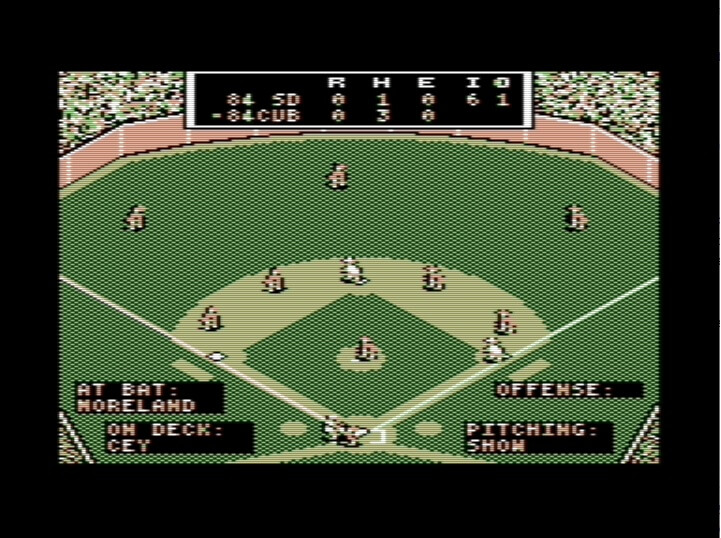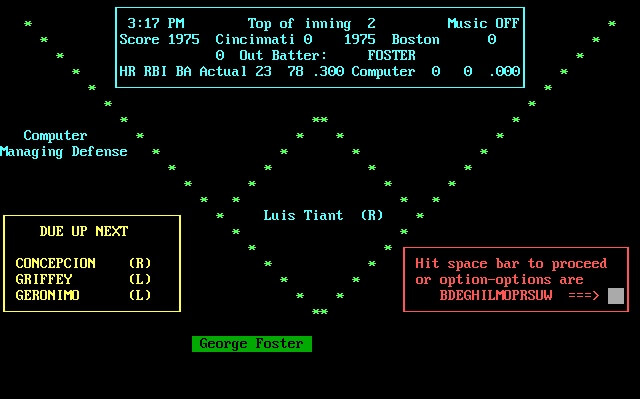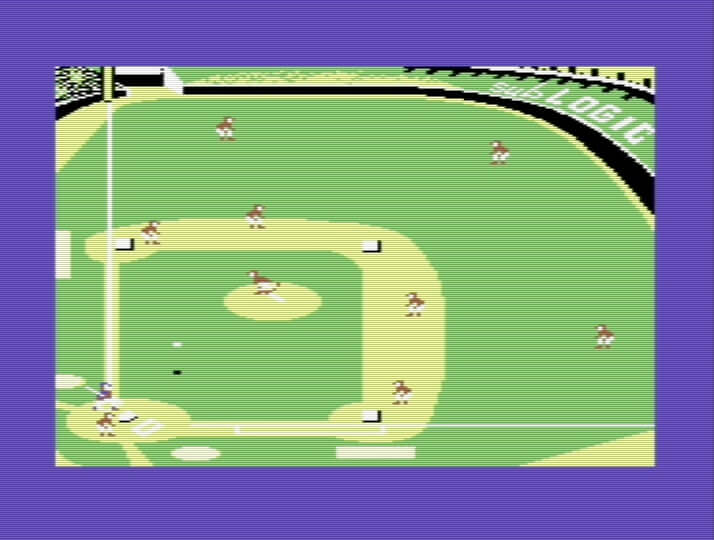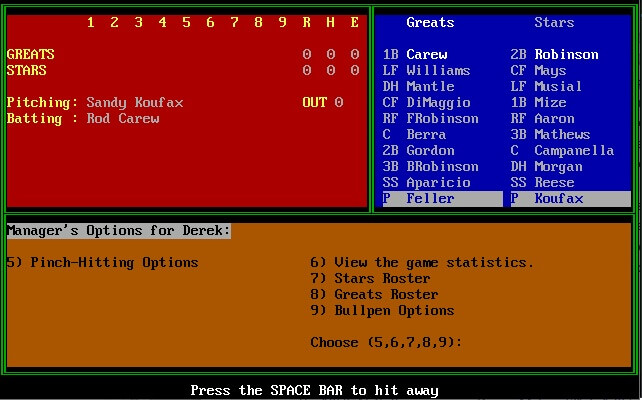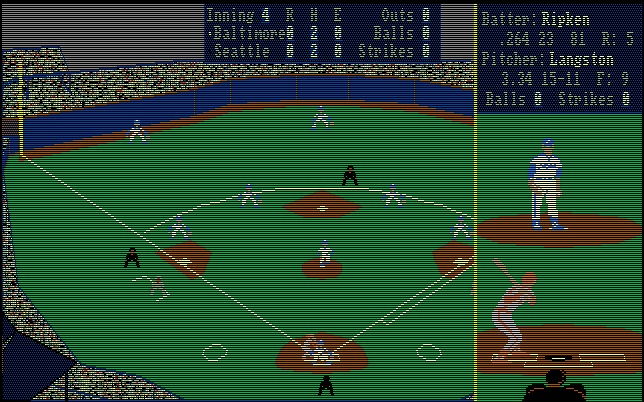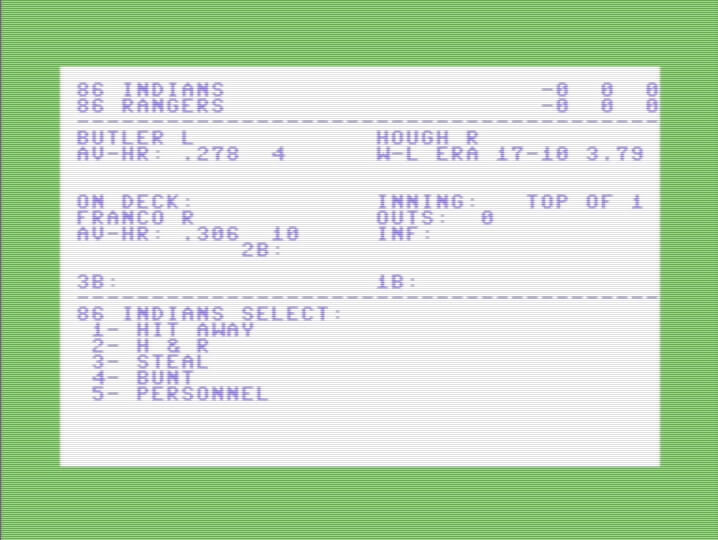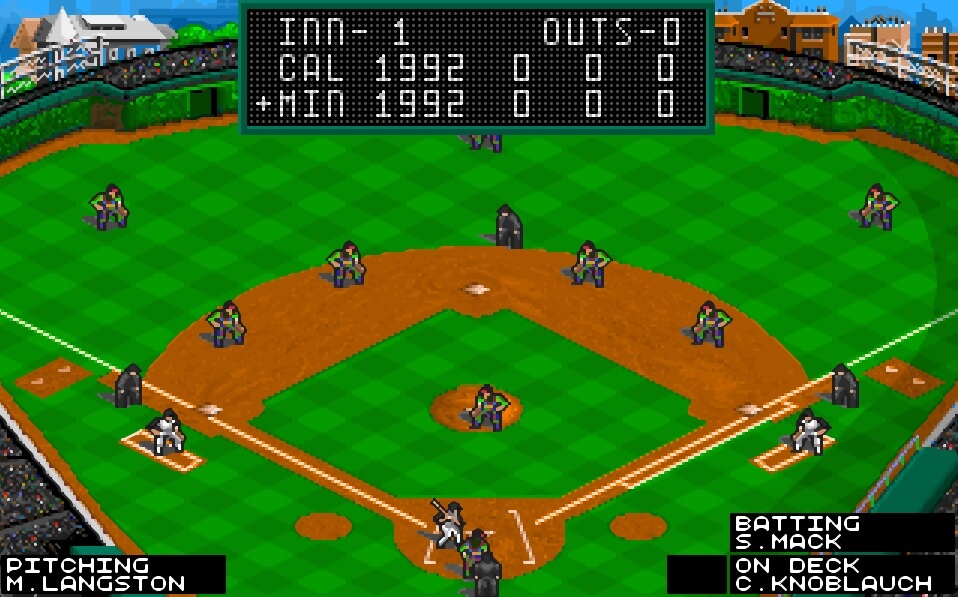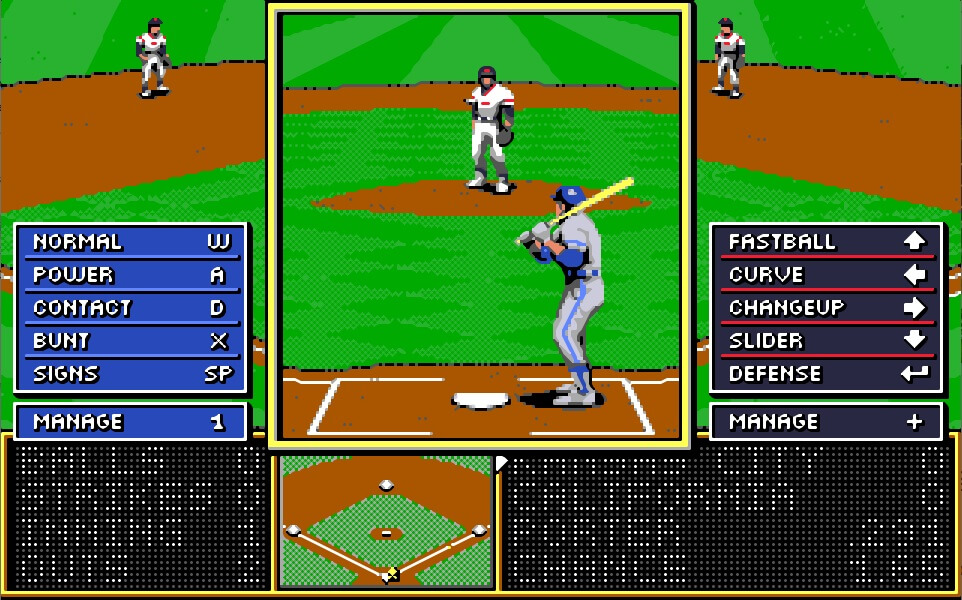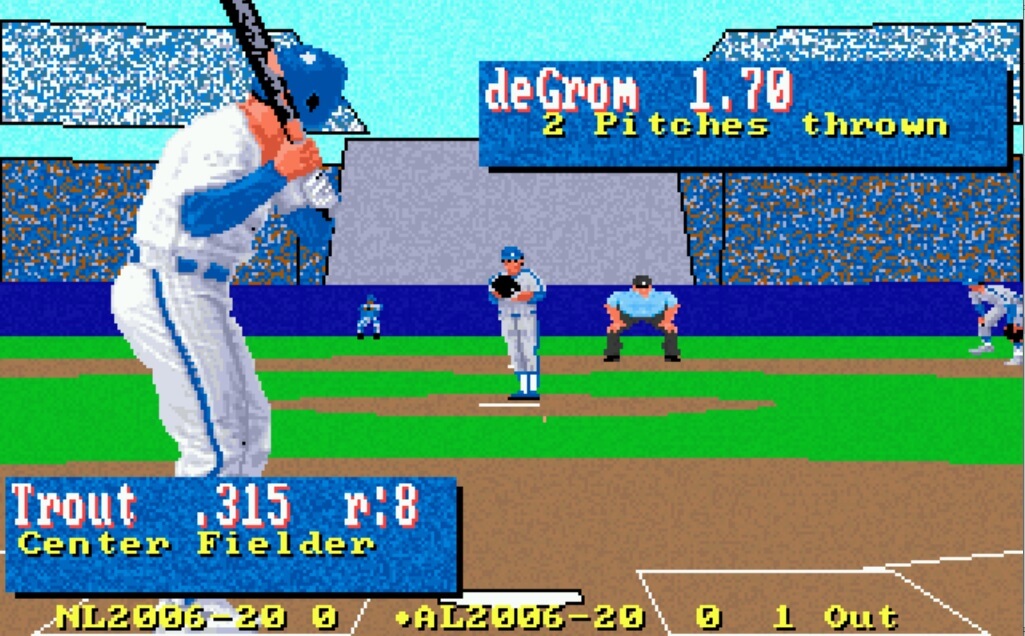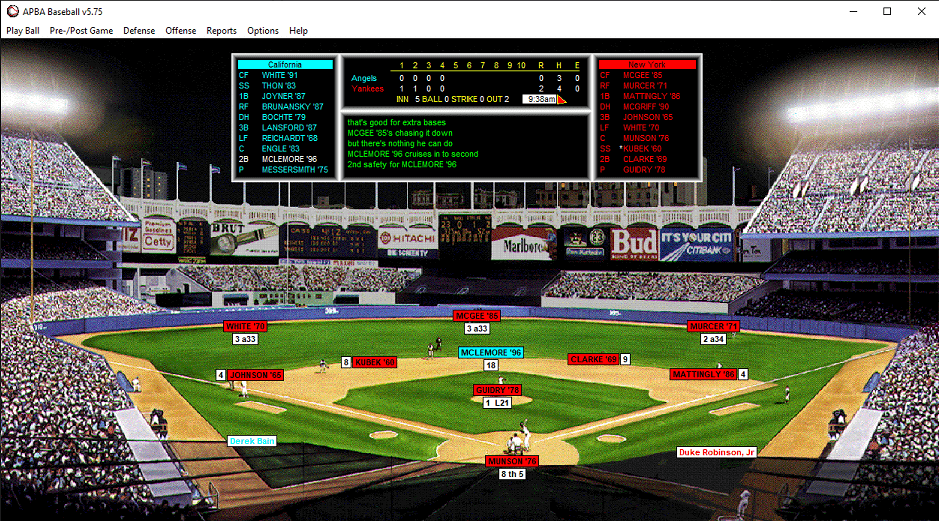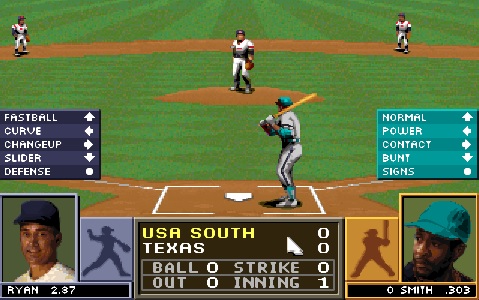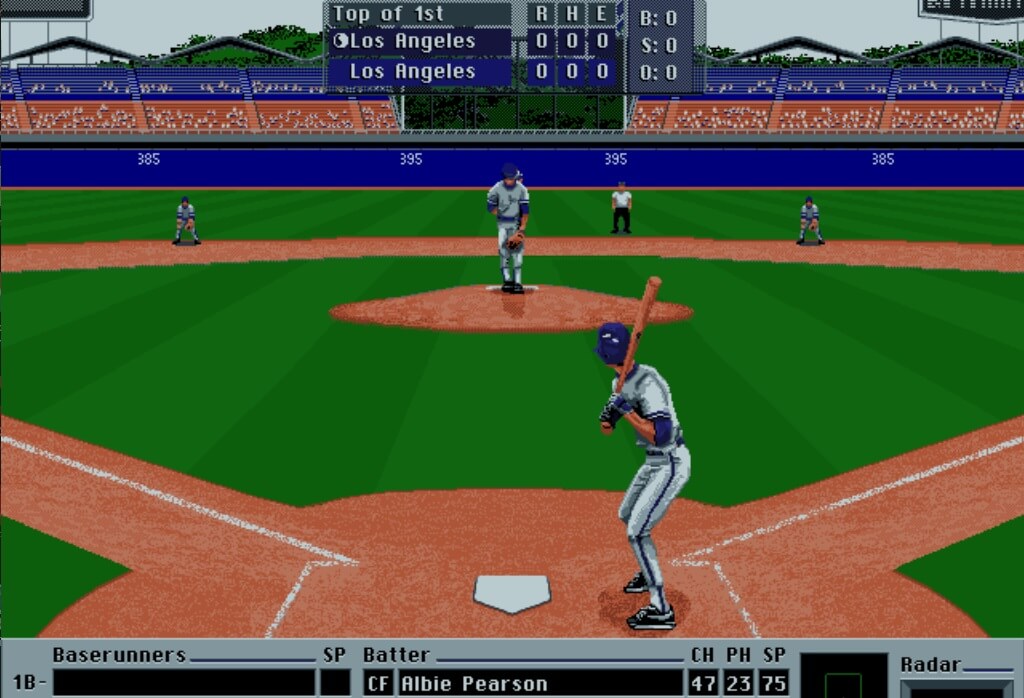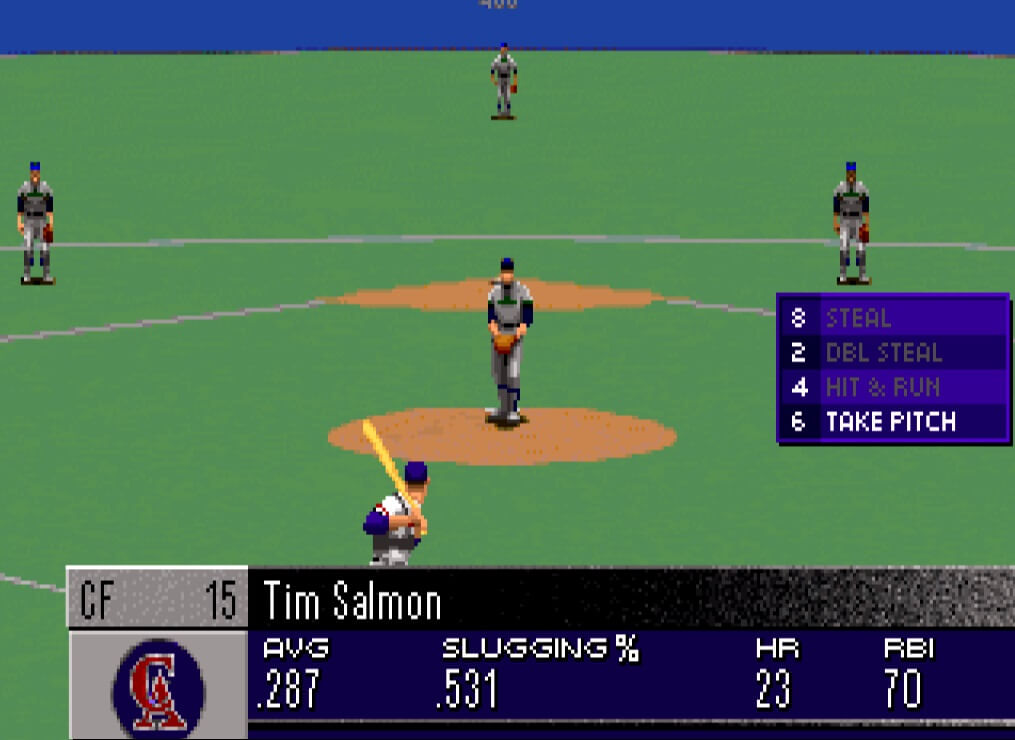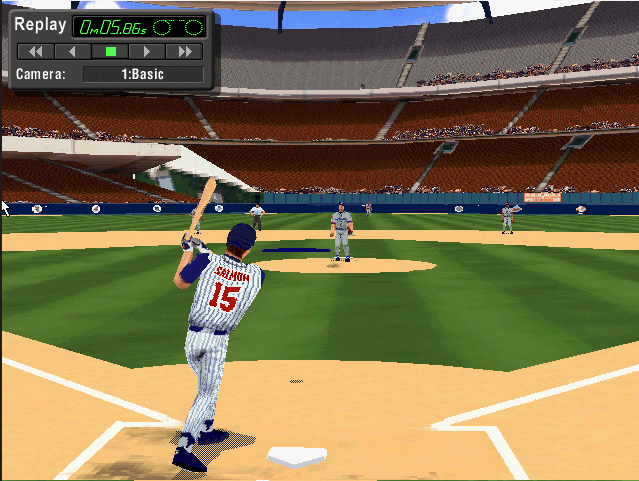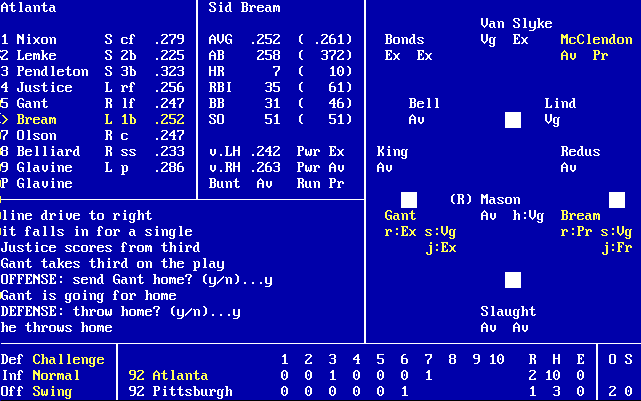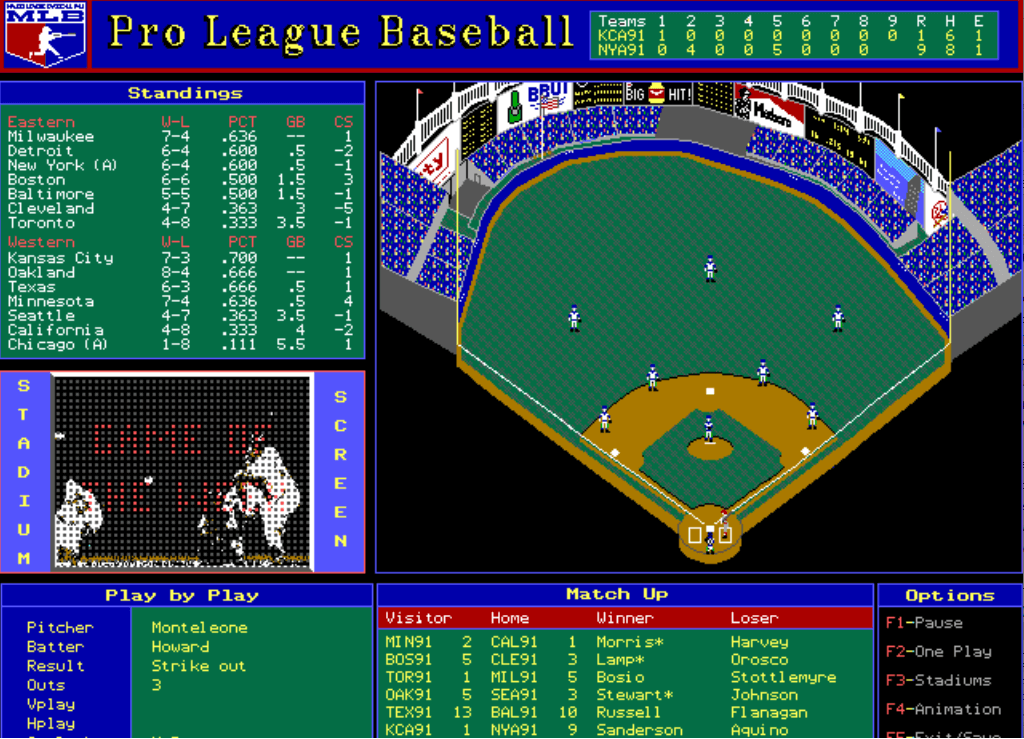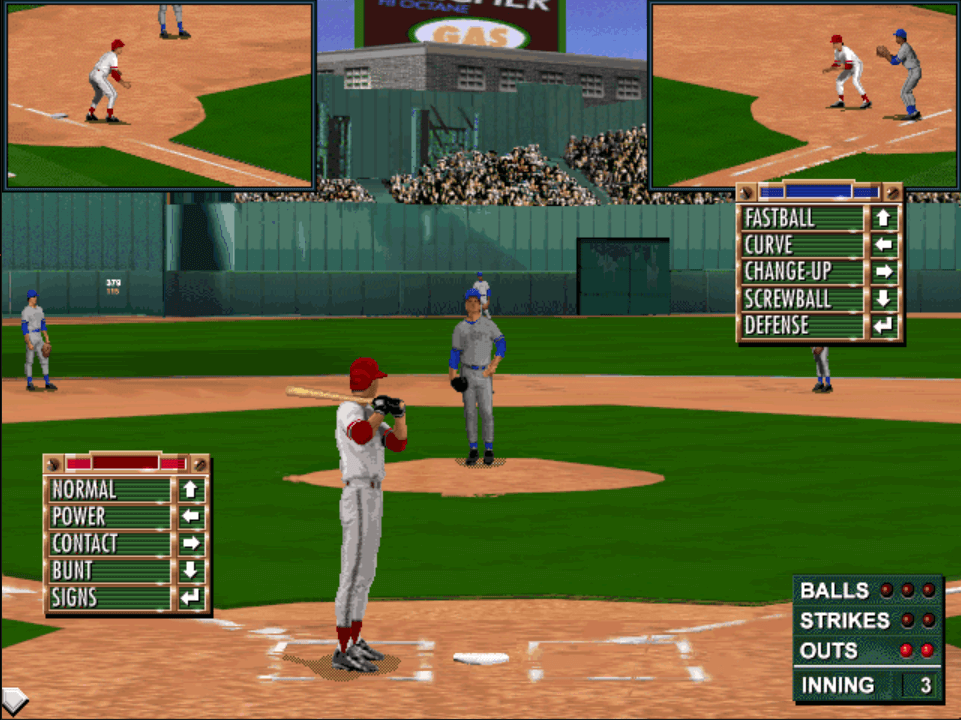This is the sixth entry in a series focusing on computer baseball simulations to supplement the chapter “Play Retro Baseball Video Games In Your Browser” from my Hardball Retroactive book along with the corresponding post at Hardball Retro. The series focuses on baseball simulations – games in which the primary emphasis is on managerial strategy and the ability to replay entire seasons with a degree of realism. Baseball video games that are strictly arcade representations of baseball (based solely on reflex and hand-eye coordination) are excluded.
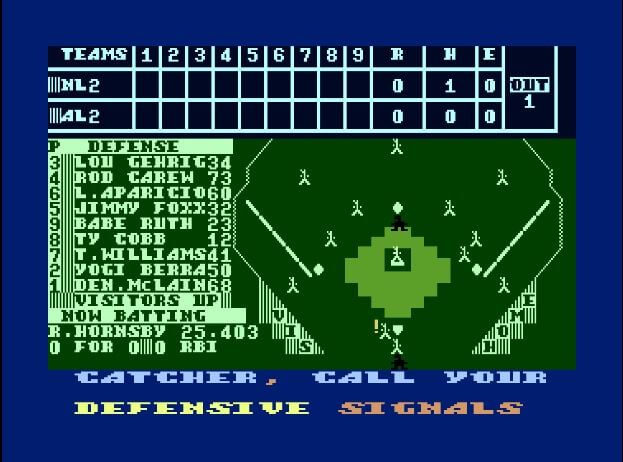
Publisher – TK Computer Products
Release Year – 1986
Platforms – Apple ][, Atari 800, Atari ST, Commodore 64, IBM PC
Credits
Unknown – if anyone can provide this information, please post a Comment and I will update this section accordingly.
Review
Monday Morning Manager continues the tradition of the primarily text-based predecessors like SSI Computer Baseball and Computer Statis Pro Baseball. Sadly it fails to offer any tangible improvements over those offerings and in some respects the product presents fewer choices to the end-user.
Unable to locate my Monday Morning Manager (Commodore 64) floppy or game manual, I launched the Atari 800 version of the game using the Altirra emulator. I encountered a glitch when attempting to visit the mound or review my lineup during the game. The program tried to list my roster but crashed every time. My assumption is that the disk image is corrupt and that this flaw did not exist in the original version of the game. I decided to play a series of exhibition game between the AL and NL Greats to get a feel for the interface, with the caveat that I would be unable to make any in-game substitutions. In my initial endeavor, the computer manager visited the mound which resulted in the aforementioned crash bug. Consequently I resolved to manage both squads through a three-game set in an effort to complete an entire game, figure out the available options (without making any in-game substitutions) and view the resulting box score.
The 1968 AL Cy Young winner Denny McLain (31-6, 1.96) accepted the starting assignment against 1965 NL Cy Young honoree Sandy Koufax (26-8, 2.04). The “Iron Horse” Lou Gehrig kicked off the scoring with a solo blast to center field with one out in the bottom of the second. Following a walk to Mickey Mantle and an opposite-field single by Ted Williams, the AL squad tallied their second run on a two-base hit down the left field line by Yogi Berra. Koufax whiffed Luis Aparicio but Ty Cobb ripped a solid single to center to knock in “Teddy Ballgame” for a 3-0 lead. McLain got into trouble in the bottom of the fourth when Johnny Mize and Hank Aaron delivered back-to-back singles to place runners on first and third with nobody out. He struck out Eddie Mathews and Gabby Hartnett in succession then retired Pete Rose on a line drive to “Little Louie”. The AL Greats loaded the bases with one away in the fifth on a single by Rod Carew along with pair of walks to Babe Ruth and Jimmie Foxx. Koufax extricated himself from the jam with successive strikeouts of Gehrig and Mantle. The NL Greats were unable to mount any offense against McLain as he fashioned a five-hit shutout and the AL crew claimed the first contest, 3-0.
Game 2 featured Luis Tiant ’68 (21-9, 1.60) versus Tom Seaver ‘71 (20-10, 1.76). “El Tiante” struck out the side in the top of the first (Honus Wagner, Rogers Hornsby, Stan Musial). In the bottom of the frame, Ty Cobb led off with a single, stole second and came home on a two-run rocket to left-center field by Lou Gehrig. Tris Speaker extended the inning with a bloop single to left, but Seaver escaped further damage when Ted Williams lofted a lazy fly ball to Hank Aaron for the third out. Willie Mays reached on an miscue but he was consequently caught stealing on a laser throw by Yogi Berra. Hank Aaron dialed long distance with two down in the second inning to tally the National League’s first run in 11 frames and cut the deficit to 2-1. Harmon Killebrew launched a moon-shot deep over the right field wall in the bottom of the second to increase the AL’s advantage to 3-1. Gabby Hartnett and Honus Wagner supplied successive singles to start the third frame but Tiant induced Musial to ground into a 6-4-3 double play. Mize muffed Gehrig’s two-hopper to first and Speaker coaxed a walk, placing “Tom Terrific” on the ropes again. “The Splendid Splinter” ripped a hard liner to center and the third-base coach held Gehrig at third. “Killer” pounced on a curveball, drilling a two-run double down into the left field corner. Seaver recorded 3 straight outs as the NL squad clung to a 4-run deficit. “Hammerin’ Hank” plated the “Say Hey Kid” with a two-bagger into the right field corner in the top of the fourth. A base hit by Lefty O’Doul and a fielder’s choice by Eddie Mathews scored Aaron as the NL Greats inched back into the ballgame. The AL responded in the bottom of the frame when Rod Carew singled up the middle and Gehrig delivered another crushing blow, his second long ball of the game and third of the series to put his team ahead by a four-run margin. Later that inning, Killebrew connected on a mammoth blast to right-center field with “Teddy Ballgame” aboard to extend the AL advantage to 9-3. Rogers Hornsby legged out a three-base hit when the ball took a strange bounce at the base of the center field wall and eluded “The Georgia Peach”. “Stan the Man” greeted Tiant with a line shot back through the box and “Rajah” stepped on the dish to register the fourth tally for the NL. Mays rapped into a 6-4-3 double play and Aaron whiffed to end the marginal uprising. The Junior Circuit opened the bottom of the fifth with 3 successive singles by Luis Aparicio, Cobb and Carew. Seaver sustained his “Franchise” tag, escaping the bases loaded jam on short fly balls to Babe Ruth and Gehrig and a ground out by “The Grey Eagle”. Both pitchers settled in and shut down the opposition for the remainder of the game. Tiant whiffed Hornsby to seal the 9-4 victory for the American League. Minnesota teammates Carew and Killebrew led the squad with 4 hits apiece.
Dean Chance ’64 (20-9, 1.65) opposed Steve Carlton ’72 (1.97) in the series finale as the AL attempted to complete the sweep. Chance immediately encountered trouble in the first inning, loading the bases on a hit, walk and error by first baseman Lou Gehrig. Hank Aaron hammered a two-bagger into the right field corner to plate all 3 baserunners. Chance booted Ralph Kiner’s smash back through the box to extend the frame and move Aaron to third. Eddie Mathews followed with a deep fly ball to center which was flagged down by Ty Cobb for the third out. Rogers Hornsby started the top of the third with a double off the top of the right field wall. Stan Musial delivered a clean single that one-hopped Mickey Mantle in right, placing runners at the corners with nobody out. Willie Mays followed with a line-drive two-base hit over Ted Williams’ outstretched glove in left, scoring Hornsby. Aaron coaxed a base on balls, offering Kiner the opportunity to bat with the sacks full. Chance turned a dribbler back to the mound into a 1-2-3 double play. Mathews whiffed but the NL had extended their lead to 4-0. “Lefty” faced the bottom half of the order in the fifth and the AL crew generated successive singles by Mantle, Williams and Yogi Berra to bring the tying run to the dish. Luis Aparicio walked to force in a run for the Junior Circuit. Cobb laced a single to left, cutting the NL advantage to 4-2. Rod Carew lifted a shallow fly to right and the runners declined to advance. Babe Ruth demolished a heater on the inner half of the plate, sending the sphere into orbit before settling into the upper deck in right for a grand salami! Lou Gehrig ripped a two-out double and Mantle blasted a titanic shot into the bleachers in left-center as the AL notched their eighth run of the inning. “The Splendid Splinter” struck out to mercifully conclude an inning in which 11 batters came to the dish. Not ready to surrender by a long shot, Gabby Hartnett belted a long ball to left to commence the top of the sixth. Aaron lashed a two-out double down the right field line in the seventh and came around on a base knock by Kiner. Mathews drew a walk and Hartnett swatted a three-run big-fly to retake the lead for the NL squad, 9-8! “Hammerin’ Hank” launched a moon-shot in the top of the ninth to add an insurance run. In the bottom of the ninth, Carew blooped a single in front of Mays with one out to grant Ruth the chance to tie the game at 10-all. “The Bambino” grounded into a 6-4-3 double play as the National Leaguers claimed the first triumph in the exhibition match.
Ratings
Graphics – [1] The display is very reminiscent of SSI Computer Baseball. The ballplayers are represented by character graphics with stick-figures to differentiate between the batter, baserunner(s) and fielders. The ball (a single pixel) moves with a stilted motion. When the batter hits the ball, he drops the bat (which looks like an exclamation point) in front of home plate. Umpires are stationed in front of second base and behind home plate. The umpire raises his hand when an out occurs and waves his hands to indicate when a player is safe on a close play. The scoreboard appears at the top of the screen while the defensive lineup encompasses one-third of the screen on the left side. The current batter is listed below the defensive lineup along with his actual batting average and results from today’s contest. The bottom portion is reserved for prompts (“catcher, call your defensive signals” or “third base coach, give your signs”) and play-by-play commentary. Home runs trigger the scoreboard to cycle through an array of colors.
Sound – [2] The ambient crowd noise commences at game time. The crowd roars for base hits and jeers at strikeouts. The crack of the bat is audible. The applause volume spiked when the ball left the yard. When the game ends, the box score is displayed and a full rendition of “Take Me Out to the Ballgame” reverberates throughout the stadium.
Strategy – [1] Through trial and error, I discerned the joystick directions on offense selected the following plays: swing away (fire button), steal (up), bunt (down), view lineup (right). Defensive options include: pitch (fire button), pick-off attempt (left), visit mound (right), intentional walk (up). Working without the manual, I was unable to ascertain if you can call a hit-and-run or coach your baserunners to be cautious or aggressive. In the field I could not determine if it was possible to adjust my fielder’s positioning (infield in, double-play depth, in at the corners, outfield positioning). If anyone has the manual, please scan it and send it to me! As a result of the lineup screen crash bug, I don’t know whether it is possible to warm up relievers.
Artificial Intelligence – [1] As mentioned I had to manage both teams so I could not verify the acumen of the computer manager with regards to lineup changes, bullpen management and strategy.
Box Score – [1] Upon the conclusion of the contest, I was almost immediately delivered to the box score screen. The entire roster for each team is listed on the screen without sorting by the actual lineup order. Defensive positions are ignored so there’s no easy way to determine who played where, when a player substitution occurred, etc. The team total runs, hits and errors appear in the top-left corner. In the Altirra emulator, F3 mapped to the “Select” key, which toggles between the home and visitor box score. The “Option” key (F4) allows the user to print the box score. Pressing the “Start” key (F2) results in a menu with 3 choices: Play Teams Again, Play New Teams, Save All Stats.
Rosters – [1] – Each team is restricted to a 19-man roster (13 batters and 6 pitchers). Monday Morning Manager incorporates a trade / free agent draft mode. To my knowledge it is not possible to edit existing player data or create new players.
Statistics – [2] – The game disk is stocked with 32 championship teams along with 2 AL and 2 NL Greats. Data disks were available for purchase. Offensive statistics were limited to batting average, doubles, triples, home runs, RBI and stolen bases. Pitcher data referenced won-loss record, saves, walks, strikeouts and earned run average. Two fielding positions were listed for each player. However there are no ratings for speed / baserunning, bunting, or defensive ability.
Usage/Injuries/Ejections – [1] – Injuries, ejections and fatigue do not occur in the game. It is not possible to prevent the computer manager from substituting a particular player or pitcher during a game or series.
Ballparks / Park Factors – [1] –The simulation does not appear to account for any park factors. The in-game display is a character-mapped stadium. The end-user does not select the ball park.
Commentary – [1] – Play results appear at the bottom of the screen. They do not include any descriptive text. Standard responses are “walk”, “single”, “pop out” and “runners go.. he’s safe”.
Scale: Ratings from 1 (worst) to 5 (best)
Total Score: 12 out of 50
Observations
Monday Morning Manager delivers a basic text-based baseball simulation with none of the bells and whistles to differentiate it in a market that was expanding in the mid-Eighties. This game was difficult to find back in the day (it may have only been available through mail-order). I don’t recall specific flaws with the Commodore 64 version but I know I didn’t spend a lot of time with this game. The roster limitations and lack of statistics probably expedited my decision to banish this floppy to the bottom of the pile.
Please add a comment below if you spent a significant amount of time and/or have any recollections of Monday Morning Manager.
Screenshots
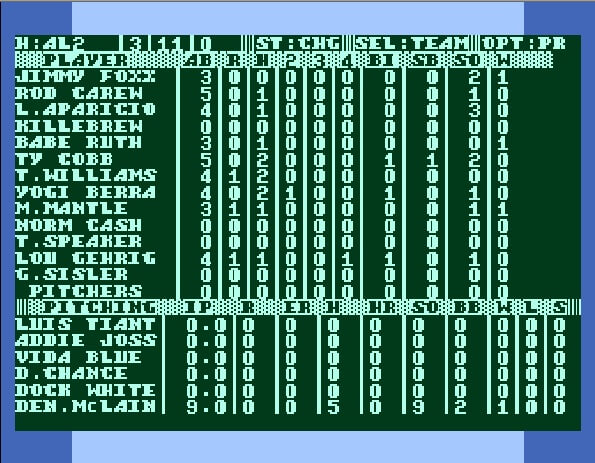
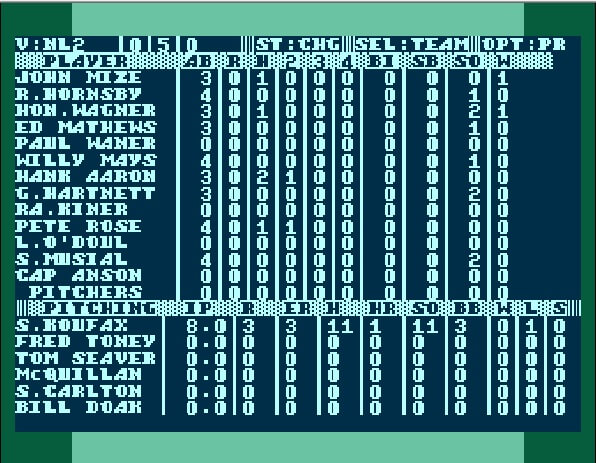
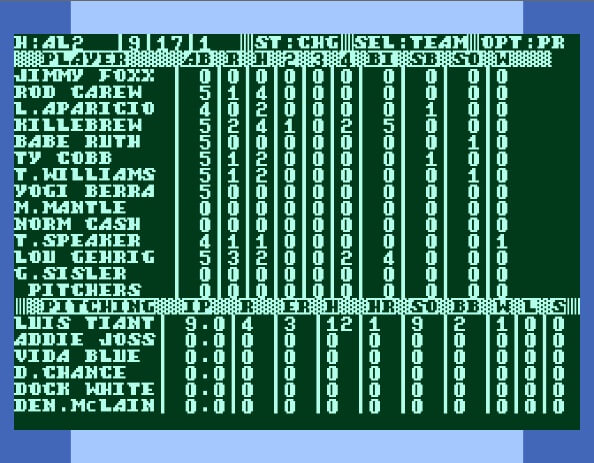
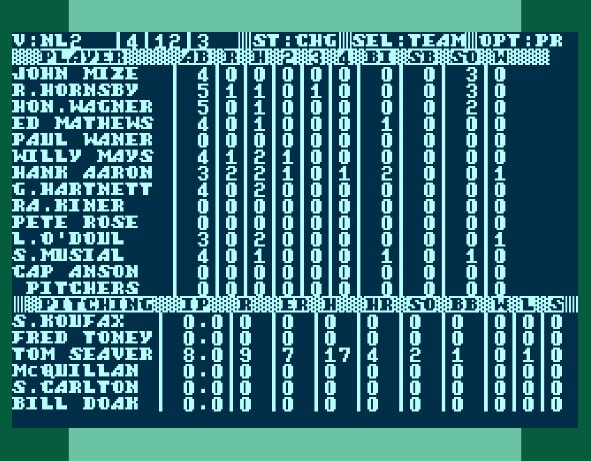
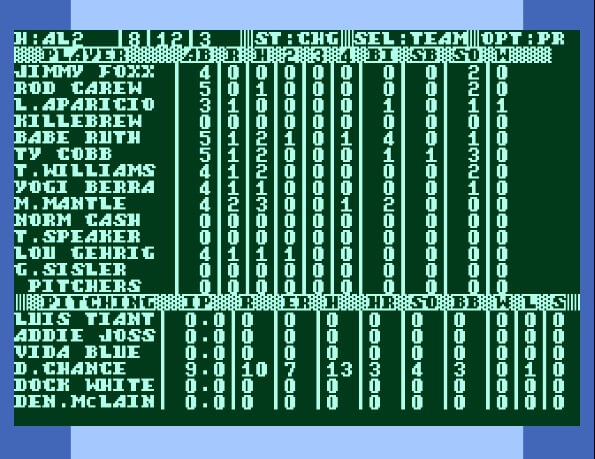

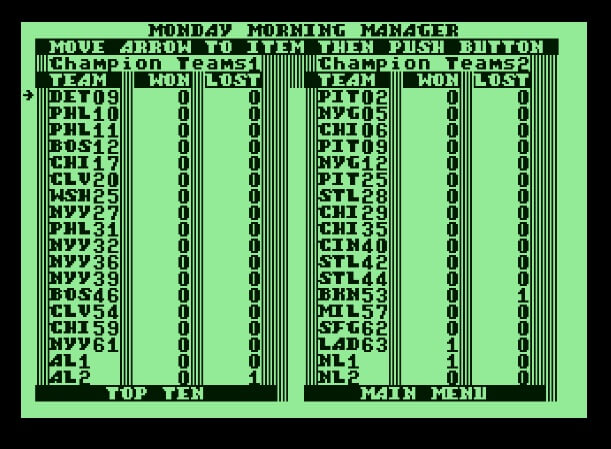
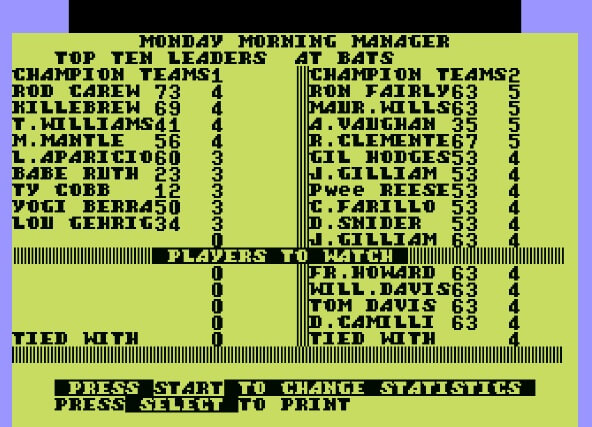
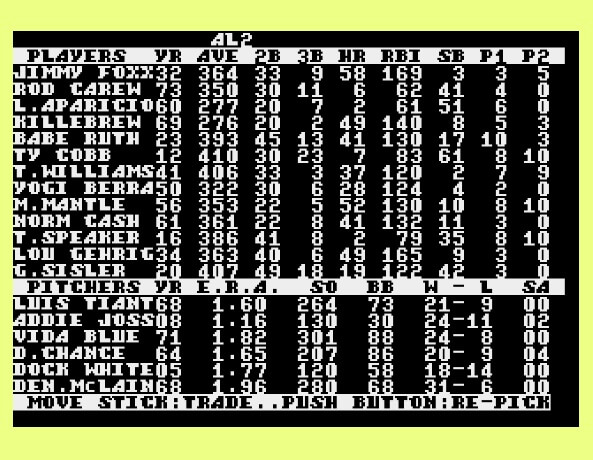
Articles in the Series
Additional Links
https://archive.org/details/1986-06-compute-magazine/page/n114
Playthroughs – Hardball Retro
Atari 8-bit version:
Atari Explorer, Spring 1987. Letters to the Editor. “Update for Baseball Fans”. Page 4. https://archive.org/details/Atari_Explorer_Volume_7_Number_2_1987-03_Atari_Explorer_Publications_US/page/n5
About the Author
I am a New Jersey native with a passion for baseball, statistics, computers and video games who enjoys spending quality time with his family.
“Hardball Architects – Volume 1 (American League)“, published in July 2020 and
“Hardball Architects – Volume 2 (National League)”, published in April 2022, examine the trades, free agent acquisitions, draft picks and other transactions for the 30 Major League Baseball franchises, divided into a 2-volume set. Both books are available in paperback and digital (Kindle) format at Amazon.com. All key moves are scrutinized for every team and Sabermetric principles are applied to the roster construction throughout the lifetime of the organization to encapsulate the hits and misses by front office executives. Team performances are analyzed based on transaction type with graphs depicting the WAR (Wins Above Replacement) in every decade. Individual results for each player-transaction is charted over the duration of their stint with the franchise. Every team chapter includes All-Time Rosters and Single-Season Leaders based on transaction type. The Team Trade Record chronicles the WAR and WS (Win Shares) accumulated by players acquired in comparison to those traded to opposing teams. The opening chapter is devoted to the Evolution of the General Manager and incorporates a discussion with former Dodgers GM Fred Claire (along with former Angels and Red Sox GM Mike Port and current Reds GM Nick Krall in Volume 2) on a variety of front office topics.
“Hardball Retroactive”, published in June 2018, is available in paperback and digital (Kindle) format at Amazon.com. Hardball Retroactive is a modest collection of selected articles that I have written for Seamheads.com along with my Baseball Analytics blog since 2010. Exclusive content includes the chapter on “Minors vs. Majors” which assesses every franchise’s minor league successes and failures in relation to their major league operations.
“Hardball Retrospective” is available in paperback and digital (Kindle) format at Amazon.com. Supplemental Statistics, Charts and Graphs along with a discussion forum are offered at TuataraSoftware.com. In Hardball Retrospective, I placed every ballplayer in the modern era (from 1901-present) on their original teams. Using a variety of advanced statistics and methods, I generated revised standings for each season based entirely on the performance of each team’s “original” players. I discuss every team’s “original” players and seasons at length along with organizational performance with respect to the Amateur Draft (or First-Year Player Draft), amateur free agent signings and other methods of player acquisition. Season standings, WAR and Win Shares totals for the “original” teams are compared against the real-time or “actual” team results to assess each franchise’s scouting, development and general management skills.
Don Daglow (Intellivision World Series Major League Baseball, Earl Weaver Baseball, Tony LaRussa Baseball) contributed the foreword for Hardball Retrospective. The foreword and preview of my book are accessible here.
“Hardball Retrospective – Addendum 2014 to 2016” supplements my research for Hardball Retrospective, providing retroactive standings based on Wins Above Replacement (WAR) and Win Shares (WS) for each “original” team over the past three seasons (2014-2016). Team totals from 2010 – 2013 are included for reference purposes. “Addendum” is available in paperback and digital (Kindle) format at Amazon.com.
NOTE: Original article posted on the Hardball Retro website, November 30, 2019.
A lifelong resident of central New Jersey, I enjoy spending quality time with my wife and three children. In my professional life I’ve worked for three local healthcare systems as a server and network administrator over the last 30 years. Co-chair of the SABR Games and Simulations Committee since August 2022 along with Mark Wendling.
My hobbies include baseball, statistics, computers and video games along with freshwater fishing. I have authored five books and contributed articles to Seamheads, Fangraphs and my site, Hardball Retro. Follow my HardballRetro channels on Twitch for live-streaming of classic and current baseball video games and view the resulting playthrough videos on YouTube!
Visit my Amazon author page to check out my books, promotional videos, and post a review if you're a Hardball Retro fan!
My Books:
"Hardball Retro’s Compendium of Baseball Video Games and Electronic Handhelds," published in September 2024 with co-author John Racanelli, is available in paperback and digital (Kindle) format at Amazon.com.Hardball Retro’s Compendium of Baseball Video Games and Electronic Handhelds was recognized with the 2025 Sporting News-SABR Baseball Research Award.
“Hardball Architects – Volume 1 (American League Teams)”,published in July 2020, is available in paperback and digital (Kindle) format at Amazon.com.
“Hardball Architects – Volume 2 (National League Teams)”,published in April 2022, is available in paperback and digital (Kindle) format at Amazon.com.
“Hardball Architects” examines the trades, free agent acquisitions, draft picks and other transactions for the 30 Major League Baseball franchises, divided into a 2-volume set (American League and National League). All key moves are scrutinized for every team and Sabermetric principles are applied to the roster construction throughout the lifetime of the organization to encapsulate the hits and misses by front office executives.
“Hardball Retroactive”,published in June 2018, is available in paperback and digital (Kindle) format at Amazon.com. A cross-section of essays that I penned for Seamheads.com along with my Baseball Analytics blog spanning nearly a decade touching on subjects including "Taking the Extra Base", "General Manager Scorecard", "Worst Trades", "BABIP By Location" and "Baseball Birthplaces and the Retro World Baseball Classic". Rediscover your favorite hardball arcade and simulations in "Play Retro Baseball Video Games In Your Browser" or take a deep dive into every franchise's minor league successes and failures in relation to their major league operations in "Minors vs. Majors".
“Hardball Retrospective” is available in paperback and digital (Kindle) format at Amazon.com.Supplemental Statistics, Charts and Graphs along with a discussion forum are offered at TuataraSoftware.com. In Hardball Retrospective, I placed every ballplayer in the modern era (from 1901-present) on their original teams. Using a variety of advanced statistics and methods, I generated revised standings for each season based entirely on the performance of each team’s “original” players. I discuss every team’s “original” players and seasons at length along with organizational performance with respect to the Amateur Draft (or First-Year Player Draft), amateur free agent signings and other methods of player acquisition. Season standings, WAR and Win Shares totals for the “original” teams are compared against the real-time or “actual” team results to assess each franchise’s scouting, development and general management skills.
Don Daglow (Intellivision World Series Major League Baseball, Earl Weaver Baseball, Tony LaRussa Baseball) contributed the foreword for Hardball Retrospective. The foreword and preview of my book are accessible here.
“Hardball Retrospective - Addendum 2014 to 2016”supplements my research for Hardball Retrospective, providing retroactive standings based on Wins Above Replacement (WAR) and Win Shares (WS) for each "original" team over the past three seasons (2014-2016). Team totals from 2010 - 2013 are included for reference purposes. “Addendum” is available in paperback and digital (Kindle) format at Amazon.com.
Contact me on BlueSky - @hardballretro.bsky.social
- Derek Bainhttps://sabrbaseballgaming.com/author/dbain21/
- Derek Bainhttps://sabrbaseballgaming.com/author/dbain21/
- Derek Bainhttps://sabrbaseballgaming.com/author/dbain21/
- Derek Bainhttps://sabrbaseballgaming.com/author/dbain21/
